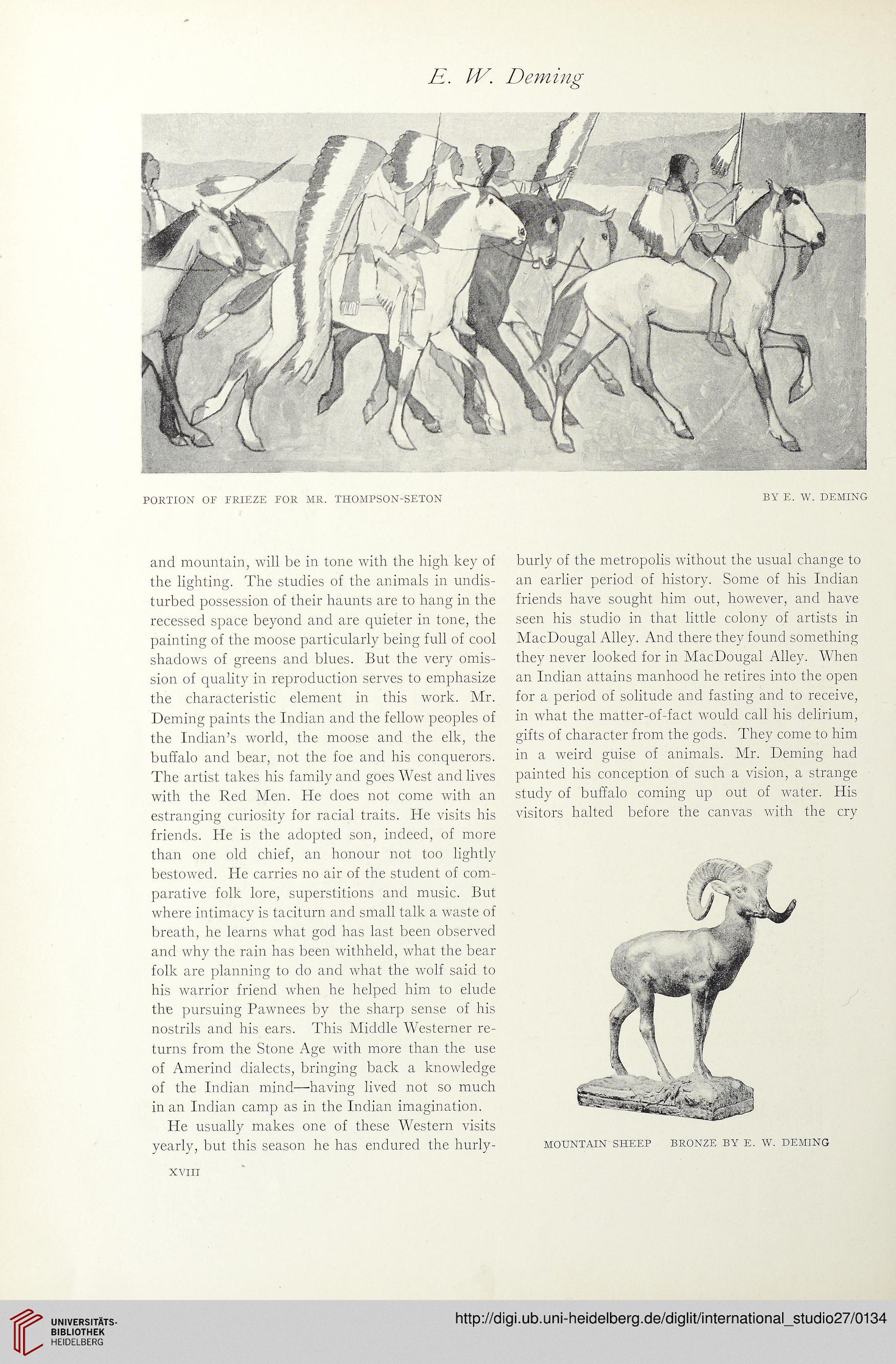E. IV. Deming
PORTION OP PRIEZE POR MR. THOMPSON-SETON
and mountain, will be in tone with the high key of
the lighting. The studies of the animals in undis-
turbed possession of their haunts are to hang in the
recessed space beyond and are quieter in tone, the
painting of the mopse particularly being full of cool
shadows of greens and blues. But the very omis-
sion of quality in reproduction serves to emphasize
the characteristic element in this work. Mr.
Deming paints the Indian and the fellow peoples of
the Indian’s worlcl, the moose and the elk, the
buffalo and bear, not the foe and his conquerors.
The artist takes his family and goes West and lives
with the Red Men. He does not come with an
estranging curiosity for racial traits. He visits his
friends, He is the adopted son, indeed, of more
than one old chief, an honour not too lightly
bestowed. He carries no air of the Student of com-
parative folk lore, superstitions and music. But
where intimacy is taciturn and small talk a waste of
breath, he learns what god has last been observed
and why the rain has been withheld, what the bear
folk are planning to do and what the wolf said to
his warrior friend when he helpecl him to elude
the pursuing Pawnees by the sharp sense of his
nostrils and his ears. This Middle Western er re-
turns from the Stone Age with more than the use
of Amerind dialects, bringing back a knowledge
of the Indian mind—having lived not so much
in an Indian camp as in the Indian Imagination.
He usually makes one of these Western visits
yearly, but this season he has endured the hurly-
BY E. W. DEMING
burly of the metropolis without the usual change to
an earlier period of history. Some of his Indian
friends have sought him out, however, and have
seen his Studio in that little colony of artists in
MacDougal Alley. And there they found something
they never looked for in MacDougal Alley. When
an Indian attains manhood he retires into the open
for a period of solitude and fasting and to receive,
in what the matter-of-fact would call his delirium,
gifts of character from the gods. They come to him
in a weird guise of animals. Mr. Deming had
painted his conception of such a vision, a stränge
study of buffalo coming up out of water. His
visitors halted before the canvas with the cry
XVIII
PORTION OP PRIEZE POR MR. THOMPSON-SETON
and mountain, will be in tone with the high key of
the lighting. The studies of the animals in undis-
turbed possession of their haunts are to hang in the
recessed space beyond and are quieter in tone, the
painting of the mopse particularly being full of cool
shadows of greens and blues. But the very omis-
sion of quality in reproduction serves to emphasize
the characteristic element in this work. Mr.
Deming paints the Indian and the fellow peoples of
the Indian’s worlcl, the moose and the elk, the
buffalo and bear, not the foe and his conquerors.
The artist takes his family and goes West and lives
with the Red Men. He does not come with an
estranging curiosity for racial traits. He visits his
friends, He is the adopted son, indeed, of more
than one old chief, an honour not too lightly
bestowed. He carries no air of the Student of com-
parative folk lore, superstitions and music. But
where intimacy is taciturn and small talk a waste of
breath, he learns what god has last been observed
and why the rain has been withheld, what the bear
folk are planning to do and what the wolf said to
his warrior friend when he helpecl him to elude
the pursuing Pawnees by the sharp sense of his
nostrils and his ears. This Middle Western er re-
turns from the Stone Age with more than the use
of Amerind dialects, bringing back a knowledge
of the Indian mind—having lived not so much
in an Indian camp as in the Indian Imagination.
He usually makes one of these Western visits
yearly, but this season he has endured the hurly-
BY E. W. DEMING
burly of the metropolis without the usual change to
an earlier period of history. Some of his Indian
friends have sought him out, however, and have
seen his Studio in that little colony of artists in
MacDougal Alley. And there they found something
they never looked for in MacDougal Alley. When
an Indian attains manhood he retires into the open
for a period of solitude and fasting and to receive,
in what the matter-of-fact would call his delirium,
gifts of character from the gods. They come to him
in a weird guise of animals. Mr. Deming had
painted his conception of such a vision, a stränge
study of buffalo coming up out of water. His
visitors halted before the canvas with the cry
XVIII




